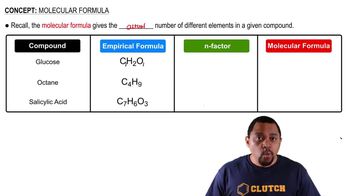A compound whose empirical formula is XF3 consists of 65% F by mass. What is the atomic mass of X?
What is the molecular formula of each of the following compounds? (a) empirical formula HCO2, molar mass = 90.0 g/mol
 Verified step by step guidance
Verified step by step guidance
Verified video answer for a similar problem:
Key Concepts
Empirical Formula

Molecular Formula

Molar Mass

The compound XCl4 contains 75.0% Cl by mass. What is the element X?
What is the molecular formula of each of the following compounds? (a) empirical formula CH, molar mass 5 78.0 g/mol (b) empirical formula NH2Cl, molar mass = 51.5 g/mol
What is the molecular formula of each of the following compounds? (b) empirical formula C2H4O, molar mass = 88.0 g/mol
Determine the empirical and molecular formulas of each of the following substances: (a) Styrene, a compound used to make Styrofoam® cups and insulation, contains 92.3% C and 7.7% H by mass and has a molar mass of 104 g/mol.
Determine the empirical and molecular formulas of each of the following substances: (b) Caffeine, a stimulant found in coffee, contains 49.5% C, 5.15% H, 28.9% N, and 16.5% O by mass and has a molar mass of 195 g/mol.
